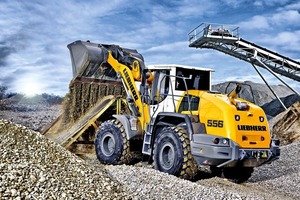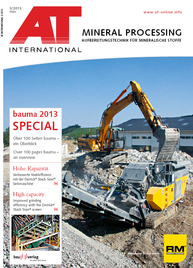Liebherr-Werk Bischofshofen GmbH
At the 2013 bauma, Liebherr is presenting its new IIIB generation of large machines for the first time to users worldwide. The L 550 and L 556 have a redesigned engine compartment with the diesel engine installed transversely. This gives them an even more compact layout, and makes all the principal maintenance points accessible from ground level. The engine output of the L 576 and L 580 models has been increased, and all the large new-generation machines have an optimised tipping load limit that further improves productivity and stability. In addition to the Z-bar linkage for standard operating tasks, Liebherr supplies industrial lift arm. No other manufacturer offers both lift arm versions in every machine category at no extra cost.
The geometry of the industrial lift arm has been specially chosen for high load moments and ample force in the upper lifting area. As a result, exceptionally heavy loads can be handled. The pattern of movement is parallel over the entire lifting range. The industrial lift has a hydraulic quick coupler as standard equipment.
For the IIIB generation, Liebherr continues to use hydrostatic drive concept together with another Liebherr development: Liebherr Power Efficiency (LPE). This is an electronic mapped-characteristic control system that increases the machine’s handling power and keeps fuel consumption to a minimum. Compared with other machines in similar size categories, the innovative driveline concept cuts fuel consumption by as much as 25 %. Less fuel is needed for the same performance, and tyre and brake wear are reduced.
The LPE system influences engine management pro-actively: the machine’s software receives an electronic accelerator-pedal position signal and computes the most efficient way of carrying out the operator’s wishes. LPE optimises interaction of the driveline components in terms of swiftness and sensitive control of the machine. The new-generation diesel engines are now even more environmentally friendly, with many other improvements, too: precision common-rail fuel injection optimises the combustion process and reduces pollutant emissions. Exhaust emission control is by means of a diesel oxidating catalytic converter combined with a diesel particulate filter. In most situations, this filter can be actively regenerated by burning off deposits during operation of the machine, and the task in hand continued without interruption.


